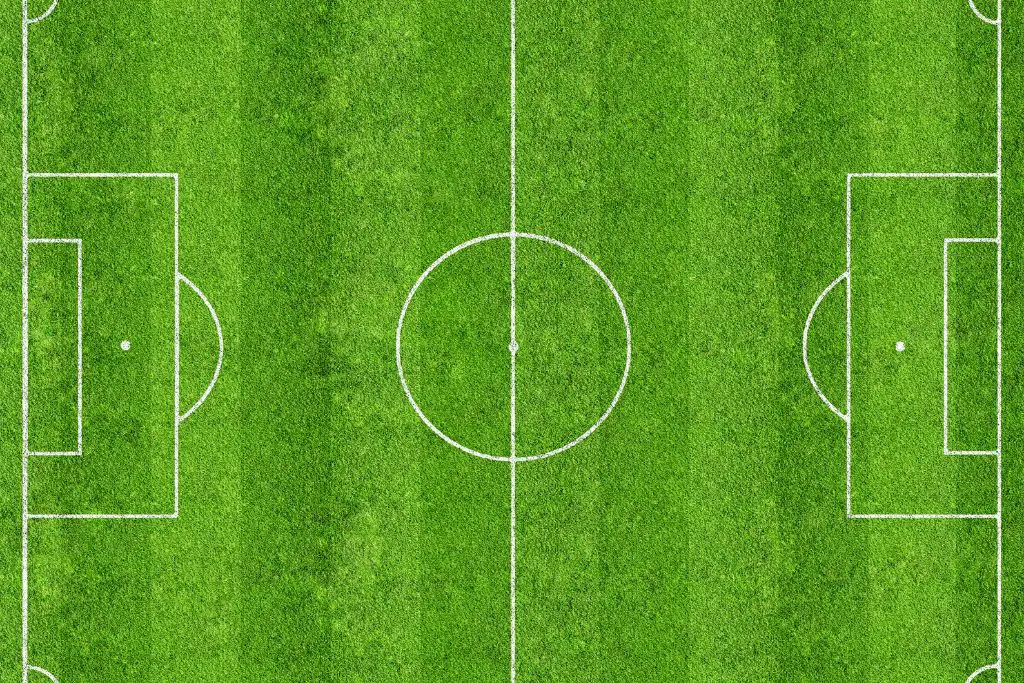While many regions use different measurement systems, soccer fields in major leagues are always measured in yards. If you’re new to soccer, soccer field measurements can seem arbitrary. What you don’t know is that quite a bit of thought and history go into these dimensions.
Soccer fields are measured in yards to keep them as consistent as possible. Since soccer is an English game, it makes perfect sense that the fields would be measured using the same units of measurement as it was when the game became popular throughout England in the 1800s.
In this article, we’ll go over why soccer fields in the United States and pretty much anywhere else in the world are measured in yards. I’ll also provide more answers to any questions about soccer field measurements.
Why Does Soccer Use Yards Instead of Meters?

The original rules of soccer, or “football,” were first codified in 1863. In those early days, the game was played with a round ball, and no formal field length was written on paper. In fact, fields in 1873 could be up to 200 yards (182.88 m) long and 100 yards (91.44 m) wide. Those measurements have been standardized today, where soccer fields measure between 100 and 130 yards (118.87 m) long and 50 to 100 yards (45.72 – 91.44 m) wide.
Soccer uses yards instead of meters to keep the measurements consistent across all fields. And while most sports use metric measurements, soccer is one of the few sports that still uses imperial measurements to measure the length of its field.
After all, soccer is a game that originated in England. And what better way to preserve the history and consistency of the rules than keeping the unit of measurement as it was 100 years ago?
Why Is It Called an 18-Yard Box?

The 18-yard (16.45 m) box goes by several names; the penalty area or simply the box. It is the large area in front of each goal post on a soccer field that extends 18 yards (16.45 m) from the goal post. Inside this area, players get the golden opportunity to attack and score.
The 18-yard (16.45 m) box gets its name because it extends 18 yards (16.45 m) from the goal line. The 18-yard (16.45 m) box measures 44 yards (40.23 m) wide, with the goalpost in the center of the box, touching the goal lines.
The 18-yard (16.45 m) box is the area around the goal where the goalkeeper is allowed to handle the ball. Additional special rules apply in the 18-yard (16.45 m) box.
For instance, the goalkeeper can only catch the ball with their hands inside this area. Suppose they do so outside the 18-yard (16.45 m) box. In that case, they commit a foul punishable by a yellow card (if it was unintentional). The offender may also get slapped with a red card if the foul was a deliberate attempt to deny the opposing team a goal-scoring opportunity.
Other rules apply to the defending team. For example, when a player from the defending team commits a foul (e.g., tripping another player from the attacking team), a penalty is awarded. The player from the defending team may be given a yellow or red card, depending on the intent.
Why Does Soccer Have a 6-Yard Box?

Besides the larger 18-yard (16.45 m) box, a smaller box is painted right in front of the goalpost. This little box provides a visual marker for defenders and goalkeepers when taking the goal kick.
Soccer has a 6-yard (5.5 m) box to mark where a goal kick can be taken. The 6-yard (5.5 m) box extends 6 yards (5.5 m) from the goal line. A goal kick is given when the ball crosses the goal line from the opponent’s team player. The same happens when the defending team’s goalkeeper catches the ball.
The 6-yard box (5.5 m) is part of the larger 18-yard (16.45 m) box. It is marked by two lines, 20 yards (18.28 m) apart. When the ball goes out of play from the end line, the goalkeeper or defender has to place the ball inside the 16-yard (14.63 m) box for a goal kick.
Why Is the Penalty Spot 12 Yards?

The distance of the penalty spot from the goal is not a random number but a carefully calculated number that has been proven to be the most beneficial for both teams. As you may have noticed, defensive players are cautious when tackling attacking players from the opponent’s team.
The penalty spot is 12 yards (10.97 m) to prevent defensive players from committing fouls so close to their goalpost. The penalty spot was introduced back in 1902 and has continued to be so in modern soccer.
Before 1902, there were no clear guidelines about where penalties should be taken. Today, a penalty kick is awarded every time a defensive player commits a foul in their 18-yard (16.45 m) box. The penalty spot is marked by a white dot 12 yards (10.97 m) from the goal post.
When a player from the defensive team (including the goalkeeper) commits a foul inside the penalty area, they may be punished with a yellow or red card, depending on the severity of the foul. All players except the defending team’s goalkeeper and set piece taker must stay outside the penalty area when the penalty is being taken.
Why Are Soccer Fields Not the Same Size?

Contrary to popular belief, soccer fields are not required to be exact measurements. In fact, most professional soccer clubs will have slightly different fields, depending on the field’s use.
Soccer fields are not the same size because of the size range provided by the governing bodies. Also, field sizes may vary depending on the number of players required for a game and the space available.
The International Football Association Board governs soccer field sizes (IFAB), which states that a soccer field should be between 100 yards to 130 yards (91.44 – 118.87 m) long and 50 to 100 yards (45.72 – 91.44 m) wide. Since the regulations by FIFA only state the minimum and maximum lengths that soccer fields should have and not specific measurements, soccer fields vary in their sizes.
As such, soccer fields can be of any size as long as the field’s dimensions remain within the dimensions defined by the soccer laws. The IFAB also states that the field should be rectangular, so although a 100 by 100 pitch does meet the requirements, it would not be allowed because it does not meet the set shape.
Additionally, soccer clubs with younger players may use smaller players. For instance, a field designed for players under ten years old could be 16 yards by 30 yards (14.63 – 27.43 m).
What Is the Size of an Indoor Soccer Field?

Indoor soccer fields are relatively smaller than those played on the outdoor pitch. They’re common in areas with weather conditions that make it difficult to play outdoor sports like Canada.
The size of an indoor field is between 100 yards to 130 yards (91.44 – 118.87 m) in length, while the width ranges from 50 to 100 yards (45.72 – 91.44 m). Players are more inclined to make low passes at such short distances than higher ones.
The official indoor soccer ball is less bouncy than a standard outdoor soccer ball for extra control. What’s more, indoor soccer fields are climate-controlled, so they are not affected by the weather.
Is Women’s Soccer Field Smaller Than Men’s?
Women’s soccer fields are the same size as men’s soccer fields, i.e., the size of a men’s soccer field is within FIFA’s regulated ranges. Unlike many sports, soccer has no gender-based differences when it comes to field sizes, goal post sizes, playtime, and ball sizes.
Both men and women can play soccer up to professional levels. And although the two are a lot alike, there are a few differences between the men’s and women’s soccer games. For instance, men’s football is generally more intense than women’s football.
How Far Is One Lap Around a Soccer Field?
One lap around a soccer field is about 360 yards and 400 yards (329.18 – 365.76 m). However, this size depends on the size of the actual field. Soccer fields should measure 110 to 120 yards (100.58 – 109.72 m) long and 70 to 80 yards (64 – 73.15 m) wide.
How Much Does It Cost To Rent a Soccer Field?

Whether you want to host an adult league game or just want to practice your skills somewhere other than your driveway, renting a field can save your day. But how much does that cost?
It costs about $450 an hour to rent an entire soccer field. This amount depends on several other factors, such as how long you intend to rent the field, its size, location, and, more importantly, the field owner’s charges.
Soccer fields can also be used for other sports, training, and events. Larger stadiums with additional facilities, such as locker rooms, charge higher prices than smaller stadiums.
Conclusion
Soccer is one of the most widely played sports in the world, but its measurements are based on the customary system, which you’re now a little familiar with. Whether you’re just getting started or need a little more understanding of the game, there’s much more to learn.
Sources
- Soccer Knowledge Hub: What is the Eighteen-Yard Box in Soccer? (Explained!)
- Answers to All: What is the point of the 18-yard box?
- Authority Soccer: 6 Yard Box Soccer What Is It And What Is Its Purpose
- Your Soccer Home: Are all Soccer Fields the Same Size or Different? 3 Reasons Why
- Sports Rec: What Is the Size of a Soccer Field?
- Street Directory: Indoor Soccer Field Dimensions
- Seatac: Sport Field Rentals
- ShowSport: Why is a penalty shot taken from 11 meters away? Is it true that the goalie came up with such a punishment?
- The FA: Law 12: Fouls and Misconduct
- Sports KnowHow: SOCCER LAWS – 1863 AND TODAY

